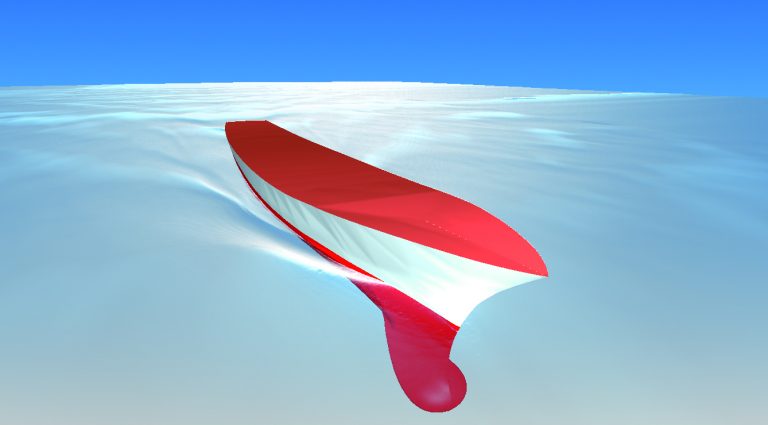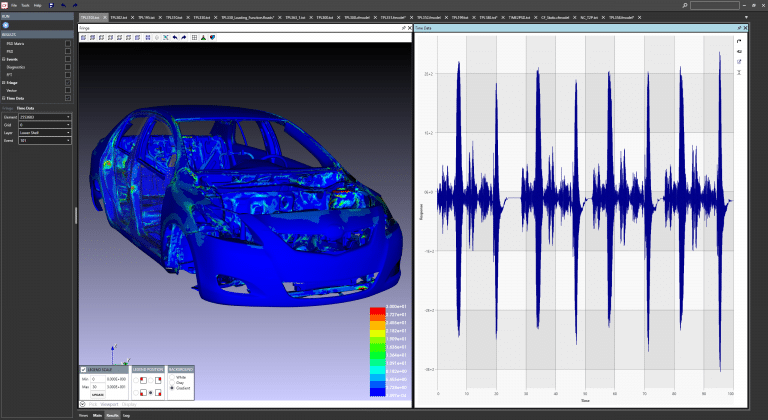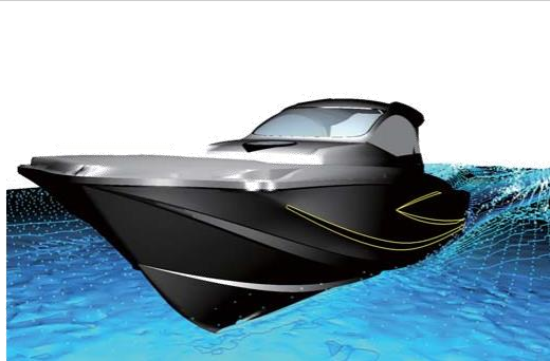FEA & CFD based Design and Optimization for Marine and Shipbuilding Industry
FEA & CFD Based Simulation Design Analysis Virtual prototyping MultiObjective Optimization
From the design and manufacture of small recreational crafts and Yachts to the large oil tankers, using FEA and CFD based simulation, Enteknograte assisting shipbuilders and boat designers to develop higher performing, safer and lower cost vessels. Through the application of simulation technology and consulting services, Enteknograte supports Marine and Shipbuilding Industry solve complex engineering challenges and mitigate environmental risks associated with seagoing loads including structural, hydrodynamics, vibro-acoustics, thermal and fatigue.

Enteknograte has a staff of highly qualified engineers and naval architects that has maintained its leading-edge know-how and development skills. Our Engineers have a rich experience in computer modeling of structures and the application of linear and non-linear (implicit and explicit) finite element codes and using advanced CFD tools in coupled with FEA to precise and real-time modeling of complicated floating structures that experience FSI for a wide range of engineering problems.
We have a proven track-record in structural analysis, marine investigation and surveying. We have a comprehensive experience in use of the most advanced computational tools to meet almost any analysis need:
- Global and detailed direct structural assessment (FEM, Finite Element Method), including verification of Fiber-Reinforced Polymer (FRP) structures for boat.
- Performance prediction based on Computation Fluid Dynamics (CFD) analysis.
- CFD studies for optimization of appendages and other elements.
- Fatigue assessment studies.
- Modal and vibration analyses.
- Seakeeping and seaworthiness assessment.
- Maneuvering studies.
- Simulation and evaluation of systems
- Marine surveying and reporting
- Damage surveys and investigations
- Tie-down structural calculations and approval
- Collision Investigation, modeling and analysis
Hydrodynamic Performance of Ship Hull
All simulations of resistance and wake assessment will be performed using advanced CFD packages. A vessel’s hydrodynamic properties, including hull design and hull-propeller interaction, resistance, maneuvering, and seakeeping, must all be optimized together in order to achieve an energy-efficient design which can perform as required under these challenging conditions. By developing a digital twin of the vessel in the design phase, our solutions allow early evaluation and optimization of hull forms under realistic conditions, helping the marine industry develop innovative, better designs faster.
Use our CFD hydrodynamic solutions to:
- Perform full-scale CFD analysis of hull forms and appendages, removing any scaling uncertainties.
- Predict hull resistance under realistic operating conditions, including waves and open water.
- Analyze vessel performance when maneuvering, including self-propulsion.
- Ensure vessel designs meet seakeeping performance criteria.
- Examine wave loading and ensure structural stability.
- Optimize hull forms or appendages, including energy saving devices.
CFD Optimization of Hull Form Including Hydrodynamics considerations
The hullform of a ship is decisive for its energy consumption and efficiency in that a large part of the overall resistance is determined by form effects and the aft body shape influences the propulsive losses. The shape related aspects are traditionally the domain of a ship model basin. While in the past numerous physical ship models have been created and tested in a towing tank to find the optimal solution, this role has been taken over by CFD, numerical methods which allow analyzing the performance of a ship hull before the first model is built. Enteknograte Engineering team use advanced CFD and Optimization software such as Ansys Fluent, Siemens Star-ccm+ and MSC Cradle to compute hull resistance at different stages of a design.


CFD Analysis of Propulsion Systems and Cavitation for Marine and Shipbuilding Industry
Use our Propulsion Systems and Cavitation solutions to:
- Predict propeller performance, including the effects of cavitation and erosion.
- Optimize propeller designs for required operational efficiency.
- Simulate self-propulsion and analyze design-critical operating conditions.
- Improve existing fleet efficiency via energy saving devices and other refit options.
- Minimize vibro-acoustics, ensuring reduced environmental footprint and structural integrity.
- Provide accurate inputs to load calculations and system simulations.
Marine Propulsion System Design: Combination of CFD & FEA for Detailed Fatigue, Strength and Vibration Analysis
Marine propulsion system designers rely on the combination of CFD and FEA software for fatigue, strength and vibration analysis. Proper propulsion system/components analyses during the design phase help avoid delays in delivery and damage problems in operation, thereby reducing expensive off-hire. Professional and reliable software and experts is essential for the design of a robust system.


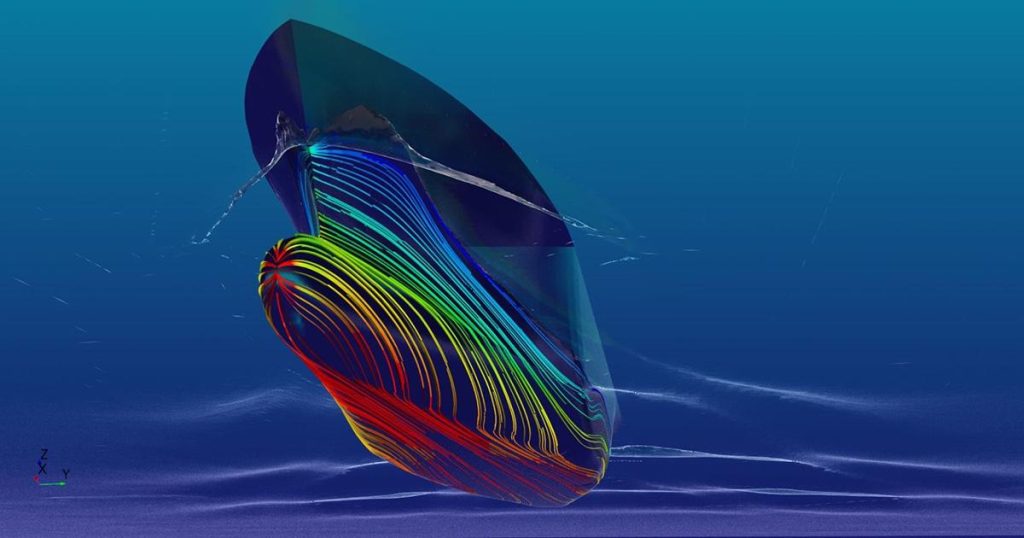
Wave-Making Resistance
Wave-making resistance is a form of drag that affects surface watercraft, such as boats and ships, and reflects the energy required to push the water out of the way of the hull. This energy goes into creating the wave. For small displacement hulls, such as sailboats or rowboats, wave-making resistance is the major source of the marine vessel drag. CFD analysis is used to lower ship hydrolic drag by optimizing ship body shape.
Enteknograte’s engineering team use a virtual Water Channel for free surface simulations. It can be used to analyze the flow around ship hulls and predict their resistance, seakeeping, loads on components, and the downstream wake of both surface and submerged watercraft. The adaptive refinement algorithm can also detect and refine dynamically and automatically the ship wake and the free-surface of the fluid.
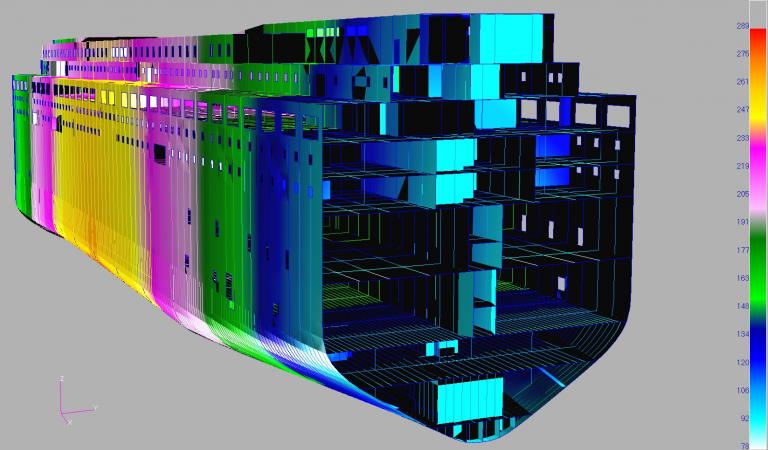
Structural Dynamics Integrity & Vibro-Acoustics Simulation for Marine & Shipbuilding Industry: CFD, FEA, SEA & BEM
Use Enteknograte FEA and CFD based structural integrity and dynamics solution services to:
- Perform a wide range of structural analysis simulations, ensuring structural integrity.
- Examine thermal and stress responses on vessel components early in the design cycle.
- Determine vibro-acoustic effects and mitigate their influence.
- Acquire physical noise and vibration data for validation and feedback on designs.
- Optimize components while maintaining performance requirements.
- Finite element modeling as per classification society guidelines
- Strength analysis, fatigue and buckling analysis of plated structures and components
- Structural reliability analysis
- Vibration investigation including measurements and theoretical analysis
- Noise investigation and analysis
- Structural analysis of specialized containers and containment systems
We optimize most complicated system in simple way, the output of simulation that represent our work quality index in critical points such as:
- Water loading and underwater radiation
- Noise in sensitive areas and changes in noise level
- Insulation optimization for weight and cost savings
- Underwater radiation from the vibrating panels
- Underwater radiation from the propeller point sources
- Interior noise levels in cabins from a number of different sources


Finite Element Analysis of Durability and Fatigue Life for Marine and Shipbuilding Industry
We use advanced CFD tools to calculate sea sate loading effect on ship and related structures and use this loading for long term assessment and fatigue analysis. Fatigue simulation is used for many types of durability analysis:
- High-cycle (S-N) Stress-Life fatigue
- Low-cycle (E-N) Strain-Life fatigue
- Neuber and other plasticity correction methods
- Crack initiation and growth using Paris
- “Hot spot” identification
- Deformation and damage analysis
- Virtual strain gauge for test-analysis correlation
- Damage accumulation using Palmgren-Miner
- Fatigue of Rotating Systems
- Vibration fatigue using random loading
- Spot and seam weld analysis
- Classic “weld classification” approach to fatigue
- Material failure predictions
- Non-proportional, multiaxial stress states
- Multiple simultaneous loads and multiple events allowed
- Safety factor analyses
With Combination of advanced FEA and Fatigue Analysis tools, we can solve complicated problem in power plant components, power station boilers, gas turbine blades and steam turbine components in high temperature field. Also this simulation is very necessary in powertrain industry in Marine and Shipbuilding related fields, where creep and creep fatigue interaction is prevalent. We can Calculate this parameters based on clients needs:
- Where fatigue cracks will occur
- When fatigue cracks will occur
- How creep mechanisms will influence fatigue life
- The factors of safety on working stresses – for rapid optimization
- The endurance of components in high temperature environments where fatigue damage mechanisms and creep damage mechanisms interact to significantly reduce component life
Coupling hydrodynamic CFD Simulation with structural finite element analysis
CFD analysis can optimize ship hull design, sail shape and propeller blades. Analysis predicts water free surface around the ship hull which helps to accomplish optimal hull shape with low hydrodynamic drag. CFD provides information to optimize sail shape and location for efficient and stable ship. CFD analysis can optimize propeller blade design for energy efficient ship and avoid cavitation on the blades. Enteknograte’s Engineering team provides analyses ranging from: ship keeping, slamming and sloshing, wave and wind loading on offshore and underwater structures, oil and pollutant dispersions and cavitation control to propulsion system optimization.
CFD codes such as MSC Cradle, Ansys Fluent, Siemens StarCCM+ and FEA Codes such as ABAQUS, Nastran, LS-Dyna and the industry-leading fatigue Simulation technology such as Simulia FE-SAFE, Ansys Ncode Design Life to calculate fatigue life and MSC Actran and ESI VA One for Acoustics and VibroAcoustics simulations. Maxsurf and AVEVA Marine used in Boat, Yacht, Marine and Shipbuilding Industry initial design step. Some of our CFD and FEA simulation based design service for marine and shipbuilding industry:
- Hydrodynamic Interaction between Bodies: shielding effects, Forward speed effects
- Shielding effects of a pier adjacent to a ship, an important aspect in the design of breakwaters and how they affect mooring systems.
- Design and analysis of mooring systems, including intermediate buoys and clump weights
- Motions analysis of FPSOs (Floating production storage and offloading)
- Calculation of shielding effects of ships and barriers
- Multiple body interactions during LNG transfer
- TLP tether analysis
- Dropped object trajectory calculations
- Concept design and analysis of wave and wind energy systems including multiphase condition including hydrodynamic effects
- Simulation of lifting operations between floating vessels
- Discharging landing craft from mother ships
- Transportation of large offshore structures using barges/ships
- Float over analyses
- Motion analysis of spar vessels
- Static and dynamic initial stability including the effects of mooring systems and other physical connections
- Coupled Hydrodynamic CFD Simulation with structural finite element analysis to Simulate Transient structural behavior in irregular waves
- Coupled cable dynamics in static and dynamic analysis to modeling of mooring system loading and response in deep waters.
- Dynamic positioning system
- Towing force provided by a tug
- Damping system with unusual characteristics
- Suction force between two ships close together, or between a ship and the sea bed
- Investigation of course keeping and turning ability
- Motions analysis of FPSOs (Floating production storage and offloading)
- Manoeuvring at low / variable speed in shallow and confined seaways/ unsteady maneuvers: tacking, gibing
- Torsional Vibration Simulation with Coupled CFD and FEA softwares to identify the interaction between components, an essential part of the system and functionality assessment
- (unlimited) deep water-Shallow water condition
- Floating wind turbine design and simulation including dynamic effects due to elastic response of wind, waves in rotor blades, the tower, and the mooring lines.
- Monohulls / conventional ships
- Multi hulls: catamarans, SWATH, trimarans
- Asymmetric ships (monohulls as well as catamarans)
- Submarines
- FEA simulation of torsional vibration regarding ice impacting on the propeller
- Fixed models as well as free to trim and sink conditions
- Coupled Hydrodynamic CFD Simulation with structural finite element analysis to Simulate transient strcutural behavior in irregular waves
- Added resistance in waves
- Combined drift and gyration
- Ship resistance analysis
- Hydrodynamic Interaction between Bodies: shielding effects, Forward speed effects
- Dynamic trim and sinkage behaviour
- Propulsion and propeller performance optimization
- Ship wake
- Shaft fatigue and lifecycle calculations of marine shafts torsional vibration stress levels based on low cycle, high cycle and transient fatigue
- Vortex induced vibration analysis
- Whipping and slamming impacts simulation: Wave-induced hull vibration for the assessment of hull girder collapse characteristics.
- Erosion CFD Simulation including hydrodynamics effects
- Offshore equipment stability: Buoyancy and centre of gravity studies
- Added masses for subsea hardware CFD calculations
- Hull performance assessment and wave-making CFD solutions
- Sea keeping behavior in regular or irregular waves
- Calculation of drag and lift on appendages
- Sail or wing optimization
- Ship structural analysis and design with FEA software such as Ansys, Abaqus and Nastran
- Hydrodynamic plant & equipment
- Tidal Power System Hydrodynamic Design
- Optimal gearbox lubrication
NVH based Design and Considerations for Marine and Shipbuilding Industry including Ship, Boat, Yacht, Vessels and offshore structures
The challenge for the NVH specialists is to support the concept and design development process by reliable recommendations just-in-time prior concept or design freeze. Enteknograte’s specialists particularly use advanced methodologies for NVH simulation and optimization for Marine and Shipbuilding Industry:
- FEA based Ship, Boat, Yacht, Vessels Powertrain
- Structural Optimization
- Optimization of Ship, Boat, Yacht, Vessels Engine Dynamics based on MBD ( Multi-Body Dynamics Simulation)
- Concurrent optimization of combustion efficiency with NVH considerations for Vessels
- Ship, Boat, Yacht, Vessels and offshore structures Interior Noise Simulation based on measurement and CAE
- Ship, Boat, Yacht, Vessels and offshore structures Exterior Noise Simulation with couple use of CFD and FEA solvers
- Objective Analysis of Sound Quality
Floating, Fixed & Gravity-Based Structures Design Including Hydrodynamics & Aerodynamics Effects
Structural Dynamics Integrity & Vibro-Acoustics Simulation for Marine & Shipbuilding Industry
Hydropower, Solar Power and Biomass
Ship Stability & Safety Analysis Including Hydrodynamics & Aerodynamics Effects
Cavitation in Propulsion Systems
Hydrodynamic Performance of Ship Hull: CFD Based Design
Hydrodynamics & HydroAcoustics simulation for AIV (Acoustic Induced Vibration)
Integrated Artificial Intelligence (AI) & Machine Learning - Deep Learning with CFD & FEA Simulation
Full Vehicle MultiBody Dynamics Simulation: Car Ride, Driveline, Engine and Tire MBD
Electromagnetic Multiphysics
Hydroplaning (Aquaplaning) Simulation
Turbine, Pump & Compressor (Axial or Centrifugal)
Multi-Phase Flows CFD Analysis
Passenger’s Thermal and Acoustic Comfort
Acoustics and Vibration: FEA and CFD for AeroAcoustics, VibroAcoustics and NVH Analysis
FEA Based Composite Material Design and Optimization: MSC Marc, Abaqus, Ansys, Digimat and LS-DYNA
Aerodynamics Simulation: Coupling CFD with MBD, FEA and 1D-System Simulation
Heat Transfer and Thermal Analysis: Fluid-Structure Interaction with Coupled CFD and Finite Element Based Simulation
Fatigue Analysis of Welded Structures
Vibration Fatigue Finite Element Simulation: Time & Frequency Domain






